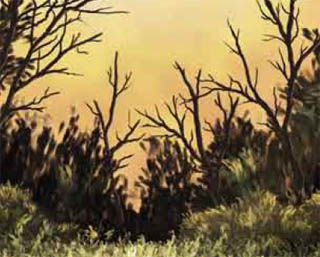
The United States is blessed with a richness of wild landscapes and attendant fish and wildlife. The diversity of landscapes is the product of geology and climate. Our access to them, however, is the legacy of untold numbers of adventurers and outdoorsmen who came first to explore, then to exploit, and finally to conserve these landscapes for themselves and their children. Today there are signs that we have grown increasingly complacent about our natural lands to the point where we risk not knowing how to find our way out…outdoors that is.
Breaking the Bond
The bond between education, understanding, and conservation is eloquently captured by Baba Dioum, founding member of the executive committee for the United Nations Program for the Environment:
“In the end, we will protect only what we love,
we will love only what we understand,
we will understand only what we are taught.”
Many researchers, notably Stephen Kellert and E.O. Wilson in The Biophilia Hypothesis, describe how our learning and experiences deeply influence what we value in nature. Our ethics and commitment to the environment are strongly shaped by the duration and character of our outdoor experiences. Because Americans are spending less time outdoors, this may have significant ramifications for people and nature alike as we become increasingly disconnected and disinterested in the outdoors. The foreword of Richard Louv’s Last Child in the Woods quotes a fourth-grader in San Diego: “I like to play indoors better ’cause that’s where all the electrical ooutlets are.
In the end, we will protect only what we love, we will love only what we understand, we will understand only what we are taught.
The foreword of Richard Louv’s Last Child in the Woods quotes a fourth-grader in San Diego: “I like to play indoors better ’cause that’s where all the electrical outlets are.”
Louv’s research led him to the conclusion that the baby boomer generation is probably the last to have built tree houses, explored creek bottoms, and run loose in the woods. Under pressure from parents and state governments to increase test scores, schools have eliminated field trips, hands-on nature study, and in some cases, cancelled outdoor recess.
At home, children too seldom hear the words “go play outside.” Parents these days feel it is there duty to keep kids safe from outside threats, but this act of safety may be causing more harm than good. Harm comes in the form of what Louv calls “nature deficit disorder.” Symptoms include an increase in Attention Deficit Hyperactivity Disorder (ADHD), childhood obesity, lack of creativity, ignorance of local flora and fauna, loss of respect for nature, and a diminishing sense of community.
While researchers debate the root causes for people spending less time outdoors and its associated impacts on our mental health, there is little debate that the trend spells trouble for our natural areas and our long-term commitment to the conservation of biological diversity.
No Child Left Inside
The No Child Left Behind Act shed light on how our educational systems too often fail to equip children to successfully compete in today’s world. But if a child’s reading aptitude and math skills are below par, what is their “Environmental IQ” score? With our population increasingly urbanized and divorced from the natural environment, can we expect our children to grasp the importance of clean water and biological diversity when they don’t understand where an egg comes from or how the water cycle works.
The environment is an extremely complex system that is constantly evolving, yet our educational efforts are often rife with a brand of simple absolutes—like recycling is good while wearing fur is bad. We must work to avoid naive renderings of the environment that impoverish rather than enrich. When the building blocks of knowledge are foregone and we lunge straight to the opinions, we are no longer educating, we are lobbying for the mind of the student.
Lack of Investment
In the nearly four decades since the first Earth Day (1970), the United States has made marked progress in natural resource conservation and environmental protection. But, by and large, the country’s efforts have stopped short of making a commitment that spans political parties, embraces all segments of our economic strata, and endures longer than a fashionable fad. In short, we have talked the talk, but shied from making the needed moral and economic investment. Witness the current push to plant corn in every corner of the country in a rush to cash in on ethanol despite the billions of tax dollars that have been paid to farmers in return for taking this very same ground out of production to conserve soil, water, and wildlife habitat.
In the end, finding our way out will take renewed effort from those who care about the future of our environment and therefore about our children’s connection to the outdoors.
The federal government places a relatively low value on environmental investments. In 2006, as an illustration of how one federal dollar was spent, 45 cents went to social security and other entitlements, 20 cents to defense, and 15 cents to debt service. Of the remaining 20 cents in discretionary funding, 2 cents went to broadly defined environmental programs. These figures also provide a poignant reminder where conservation interests sit in the real world vis-a-vis the size of the constituency for conservation relative to the size of their competition.
So, how will those of us who care about the outdoors respond? While by no means inclusive, three efforts are of particular importance—increased private investment, neighboring, and getting outdoors.
Renewed Effort
Reconnecting society with the outdoors is not the job of government. To be successful, it must be led by the private sector with government following in support. Funding for expansion of open lands and proper natural resource management is not likely without increased leadership and a broadening constituency. While numerous foundations and government programs provide funding, it is often difficult to obtain, ephemeral in nature, and inadequate to move projects from mere demonstrations to sustainable.
The environmental landscape is littered with “model” projects that ceased to exist when funding ran out. Access to larger pots of private funding are often blocked because potential returns are too small to be of interest to private equity. We see some examples of private investment funds foregoing large returns in exchange for social capital, but such efforts remain scattered and few. As Director of Conservation for the National Fish and Wildlife Foundation, I observed that innovation and sustained support come from the private sector, not from government. Let’s not look for charity, but rather seek business models that connect people with the outdoors in a manner that pays for itself.
Neighboring
Immigrants settling America met hardships with individual hard work and personal courage. Those who successfully settled the land, however, discovered long-term tenure on the land required a little assistance from one’s neighbors as aptly described by Peter Decker in a chapter of Across the Great Divide. In recent years, with a growing population of people “from away,” the cohesiveness represented by “neighboring” has fractured. A growing population believes it doesn’t need, nor is it indebted to, the larger community. The results are plain to see as disputes are settled at the courthouse instead of the kitchen table and stewardship of the land has become someone else’s responsibility.
For better or worse, we’re it…. If we succeed there will be accolades from historians. If we fail historians will, doubtless, take little notice—but history will be much different.
To restore community is a relatively straightforward process that starts with getting to know one’s neighbors and engaging in the larger community. But it goes further to include more concrete efforts such as constructively engaging developers to ensure new construction provides links to the community and the outdoors while not criminalizing outdoor play (fort building, tree climbing, etc.). And it includes making sure that our schools don’t sacrifice the outdoors on the altar of improved testing scores when the evidence suggests the opposite.
Getting Out
As stated before, we will protect only what we love. There is the obvious antidote for nature deficit disorder—getting ourselves and our children into the outdoors. This experience can be exploring the vacant lot next door, going on an overnight camping adventure, or, better yet, backpacking for a week in a wilderness area. In school, it means recognizing the intellectual benefits of the outdoor classroom for teaching math, science, and the arts.
In the end, finding our way out will take renewed effort from those who care about the future of our environment and therefore about our children’s connection to the outdoors. As Jack Ward Thomas, former chief of the U.S. Forest Service, reminds us:
These are indeed interesting times, a time of testing. It is useless to look back for the good old days—they are gone. It is pointless to look around for others to lead— they aren’t there. For better or worse, we’re it…. If we succeed there will be accolades from historians. If we fail historians will, doubtless, take little notice—but history will be much different.


